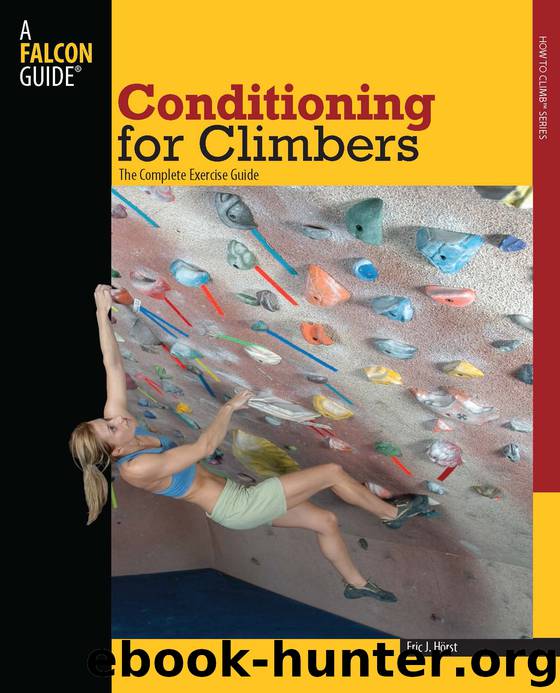Conditioning for Climbers by Eric Horst

Author:Eric Horst
Language: eng
Format: epub
ISBN: 9780762762644
Publisher: Falcon Guides
Published: 2014-10-12T16:00:00+00:00
Jonathan Manz on Fear and Loathing (5.12a), Red Rocks, Nevada. PHOTO BY ERIC J. HÖRST
Upper-Body Strength, Power, and Endurance Conditioning
A training-for-climbing program will be most effective only if it addresses your greatest weakness, whether it is physical, mental, or technical.
Although your fingers and toes are your primary link to the rock, it’s the larger muscles of your arms, legs, and torso that facilitate most of the upward movement in climbing. Of course, lack of leg strength is rarely, if ever, a limiting constraint on the rock—it’s the large pull muscles of the upper body that are most likely to fail you. Therefore, developing more upper-body strength, power, and endurance must be central to every training-for-climbing program.
Most important to climbers are the large muscles of the upper arm, shoulders, and back, including the biceps, deltoids, rhomboids, trapezius, and lats. There are many other muscles throughout the chest and abdomen that come into play as well; however, the focus of the exercises in this chapter are the workhorse pull muscles that are vital to upward movement and sustaining lock-off positions. In properly targeting these larger muscles, it is important to reduce the demands on the smaller forearm muscles so that they are not a limiting factor in training the process. By principle, specific finger and forearm training (as detailed in the chapter 6) should be a distinctly separate activity that’s completed before engaging in targeted training of the larger pull muscles.
This chapter is divided into three sections that provide specific exercises for developing limit strength, power, and anaerobic endurance. Although an exercise from one section may resemble an exercise in another section, closer study will reveal very different protocols for training strength versus power or endurance. Each of these capabilities is physiologically different, and therefore effective training of each requires a different strategy. In putting these exercises to use, it’s best to focus on a single goal for a given workout—to train strength, power, or endurance—instead of trying to train all three in a single session. Chapter 10 will then provide sample training programs and guidelines for varying your training focus to achieve optimal results in each area.
Download
This site does not store any files on its server. We only index and link to content provided by other sites. Please contact the content providers to delete copyright contents if any and email us, we'll remove relevant links or contents immediately.
Born to Run: by Christopher McDougall(7066)
Bodyweight Strength Training Anatomy by Bret Contreras(4614)
Dynamic Alignment Through Imagery by Eric Franklin(4119)
Men's Health Best by Men's Health Magazine(2551)
The Coregasm Workout by Debby Herbenick(2221)
Starting Strength by Rippetoe Mark(2079)
Relentless by Tim S Grover(2045)
Core Performance Essentials by Mark Verstegen(1982)
Endure by Alex Hutchinson(1967)
Bigger Faster Stronger by Greg Shepard(1946)
Weight Training by Thomas Baechle(1742)
Relentless: From Good to Great to Unstoppable by Tim S Grover(1652)
The Stretching Bible by Lexie Williamson(1557)
The Spartan Way by Joe De Sena(1535)
Practical Programming for Strength Training by Mark Rippetoe & Andy Baker(1531)
Good to Go by Christie Aschwanden(1447)
Dr. Jordan Metzl's Running Strong by Jordan Metzl(1382)
The Art of Throwing by Amante P. Marinas Sr(1355)
Total Hockey Training by Sean Skahan(1349)
